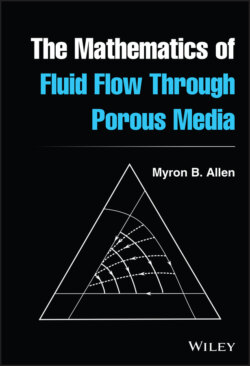Читать книгу The Mathematics of Fluid Flow Through Porous Media - Myron B. Allen III - Страница 14
1.4 Limitations in Scope
ОглавлениеThree limitations in scope are worth noting. First, we treat only isothermal flows in porous media, that is, flows at constant temperature. This restriction conveniently allows us to ignore the energy balance equation in deriving governing PDEs. On the other hand, it also eliminates several types of flows that have important applications, including flows in geothermal reservoirs and thermal methods of enhanced oil recovery, such as steam flooding.
Also glaringly absent from the table of contents is the topic of flows in fractured porous media. Geoscientists correctly point out that most geologic porous media possess fractures, which exert significant influences on fluid flows. Yet the mathematics of flow in fractured porous media remains poorly delineated, owing not so much to the absence of mathematical models (see [21] for a recent overview and [8, 15, 86, 153] for prominent examples) but, more importantly, to the observation that fractures exist at many scales of observation. In some underground formations, one must know something about the geometry of individual fractures to model fluid flows accurately. In these settings, the modeler's challenge is to represent the discrete fracture system (or statistical realizations) on tractably coarse computational grids. In other geologic settings, it suffices to treat the pore network and the fracture network as overlapping porosity systems, and the challenge is to model how fluids move within and between them. This spectrum of modeling approaches deserves a monograph of its own.
Also missing from the topics covered here is a discussion of fluid flows in extremely flow‐resistant media, often but debatably referred to as nanodarcy flows but more properly characterized as non‐Darcy flows. Flows of this type have increased in practical importance during the past two decades, owing especially to vastly improved technologies for producing natural gas from shale formations when hydrocarbon commodity prices justify the costs. The physics here are complex, involving gas–rock interactions in interstices whose typical diameters approach the mean free path of the gas molecules. None of the classical macroscopic transport models—such as Darcy's law or Fick's law of diffusion—suffices by itself to capture these phenomena [37, 81]. One can hope that further advances in our understanding of these flows, analogous to the advances described above for classical Darcy flows, will yield more settled mathematical models in years to come.
